

What the Fractal Design Meshify S2 can do for custom watercooling
With the Meshify S2, Fractal Design delivers a solid midi case with front and top mesh, which is based on the Define S2. How good is it for custom water cooling?
The Swedish case company Fractal Design is not known for extravagant cases. They are simple and without frills. Evil tongues even claim boring.
That's not entirely wrong.
The Meshify S2 is basically a Fractal Define S2 with front and top mesh. The Define S2 in turn is based on the Define R6. Fractal is therefore bringing out the same case in a slightly modified form for the third time. Be that as it may, I like the simple design. Which is why I'm jumping on the mesh bandwagon after the Define R6 and installing my components, including a complete water cooling system from Corsair's Hydro X Series, in the Meshify S2.

Modular case design
Radiators can be attached to the top, bottom and front of the Meshify S2. Up to 420 mm at the top, up to 360 mm at the front, up to 280 mm at the bottom and up to 120 mm at the rear. For those who prefer air cooling, nine fan slots are available. Removable dust filters are fitted at the bottom, front and top to prevent dust from entering the case.

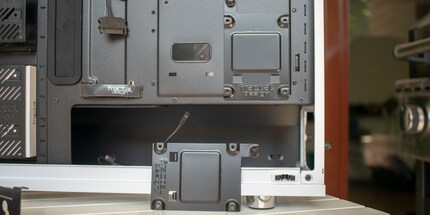
The available form factors are ATX, mATX, Mini ITX and E-ATX. E-ATX mainboards can be a maximum of 285 millimetres wide. The Meshify S2 has no space for optical drives. Three 3.5-inch and two 2.5-inch mounts are available at the rear. At the front above the PSU, two additional 2.5-inch brackets can be attached as an option. I can remove the brackets so that I have more space for water cooling, cable management or anything else.
The 538×233×465 millimetre case weighs around 10 kilograms net. It is available with a side window in black and white/black and without a side window in black. A completely white housing is missing.

The casing makes a solid impression and the majority of the material appears to be of high quality. Only the front with I/O is made of plastic. That looks a little cheap. An unattractive side effect of this is that the white colour of the front does not match the white of the rest of the case.
How does it build inside
Every time I build a new PC, I think to myself: this case should have enough space to fulfil my expectations. And every time I'm proved wrong. Let's see if I'm the same with the Meshify S2.
First, I remove everything that can be removed with screws. This includes the drive mounts, filters and the entire front. I can only remove the latter completely if I unscrew the front connection panel. This is awkward, especially as the panel is barely accessible with a screwdriver.
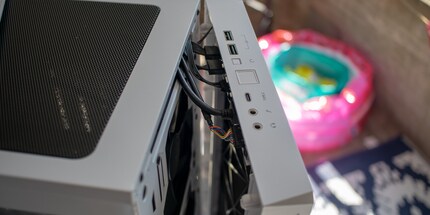
The front part of the PSU cover can also be removed. This gives me access to the lower radiator. In the front, I can mount the fan and radiator on the entire surface. The rear panel to the right of the mainboard, on the back of which the 3.5-inch brackets are located, can also be removed with screws. The rest of the case is riveted. If I wanted to modify these parts, I would have to drill out the rivets.
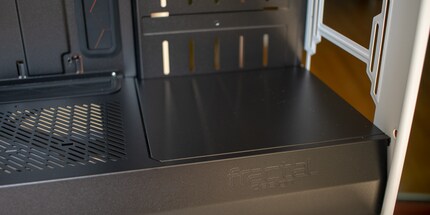

For the test, I leave the housing in its current state. I sprayed the removable rear panel matt white for the build. Also to test whether the material can be sprayed well. For your information: it does. The colour holds well, even without sanding.
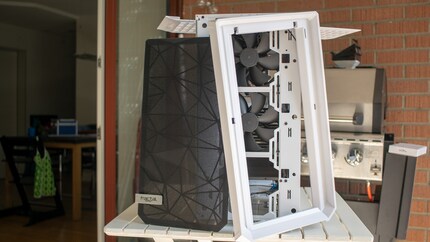
First steps
Next, I install the components. This is tricky. I'm not talking about the usual suspects like motherboard, RAM and CPU. Fractal has taken care of that and placed holes for the cables in all the important places. It's the same system as the other Fractal cases and works perfectly. What I mean is a 360 mm radiator, a 280 mm radiator and the reservoir with pump.

I can't install the 280 radiator on top. It's too wide and bumps into my High Rise RAM. With High Rise RAM, the case is only suitable for radiators with 120 mm fans. I therefore decide to install the 360 at the top and the 280 at the front.
First of all, I want to position the inlet and outlet ports of the 360 radiator at the back of the case. In a video by JayzTwoCents, I saw that he runs the tube that connects the top radiator to the front radiator to the rear radiator in front of the top radiator. I want to try that too. Then realise that's not possible.
Bummer
Two reasons for failure: Since I have high rise RAM, I have to place the 360 radiator at the edge of the case. I have no room for the tube there because of the side window. It wouldn't work otherwise either, as I can't place the 280 mm radiator at the right height at the front - I can't move the radiator in steps due to the mounting options at the front. This means that I can't screw the radiator on at the exact height at which I would like to place it.
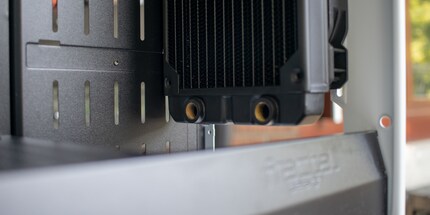
I decide to turn the 280 radiator round and place the inlet/outlet ports at the bottom. As I quickly realise, I can't mount it the way I want it either. For the next version of the housing, a step-free mounting option would be useful. It would also make sense to extend the height of the case above the mainboard. This would allow wider radiators to be installed at the top, even with high-rise RAM.
A new plan for the 280 radiator is needed.
Should I mount it at the bottom? I've never done that before. Nevertheless, I'll give it a try. In terms of length, the radiator fits because my power supply unit is only 15 centimetres long. But with longer power supply units it's going to be tight. Whether the fans can draw in enough air remains to be seen. There is only just over two centimetres of air between the case and the floor on which the case stands. I may have to screw on slightly higher feet later for better cooling performance.
The bracket for the top radiator can be removed. This allows me to mount it and the fans conveniently outside the case. The bracket also has a filling port, but this is not compatible with the adapter for the Corsair Hydro X Series, which I install in the case.
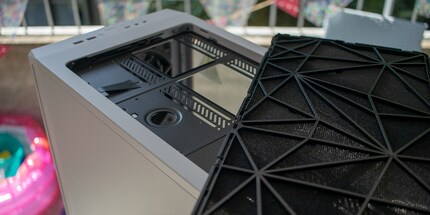
Gag and cable management
Fractal has thought of almost everything when it comes to cable management on the front of the case. The housing feed-throughs are perfectly positioned for front connections, mainboard and graphics card cables and offer sufficient space. The only thing I couldn't find a practical solution for was the RGB cable for my reservoir. This is located in front of the removable rear panel. Although the rear panel has slots through which I can insert the cable after removing the connector, the cable is still visible. I don't like that. That's why I don't use RGB bling on the reservoir.
The cables for the top, front and bottom fans are also no problem. Strategically placed small openings allow the cables to be routed invisibly to the rear. This makes cable management fun even for me as a cable hater.
On the rear of the case, I find Fractal's solution less clever. The manufacturer includes a fan controller. This is great, but because I rely on Corsair and Thermaltake fans, the controller is of no use to me. Fortunately, it can be removed with two screws. Unfortunately, this does not apply to the spacers to which the controller is attached: they are welded and take up space for my controllers. In the next version, it would be great if the spacers could also be easily removed.
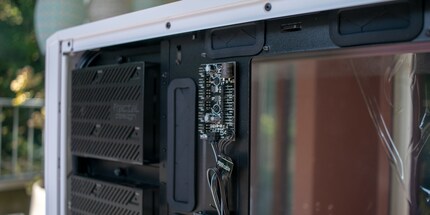
I also find the space for the cables a little tight, especially in the depth. I rely on sleeved cable extensions. With these and the original power supply cables, it gets pretty cramped at the back of the case. There is also a lack of space for the fan controller.
The removable rear panel is offset further into the case. However, as I sprayed it white and the side panel is also white, cables and controllers can be seen through the slits in the rear panel. The slots are not ideal for a clean look. They are not even suitable for attaching the reservoir - they do not have the correct spacing. This is astonishing, as the mounts for the 120 and 140 mm fans and radiators are standardised.
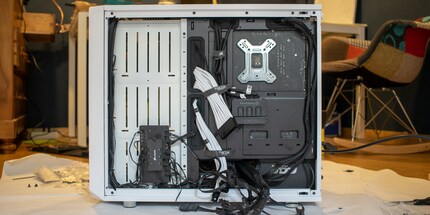
I also miss effective cable guides. There are two Velcro straps, but only in the centre of the back of the case - and this is exactly where the space in the depth is missing. I have to use cable ties on the left and right and the cables somehow end up between the rear panel and the back of the case. With all the fans, controllers and other cables, there's not enough space. The case should be one to two centimetres wider to leave enough space for cable management. The cables could then also be cleverly hidden under a self-cut acrylic panel.
A good case, with room for improvement
With the Meshify S2, Fractal Design delivers a case that is particularly interesting for design purists. Only NZXT builds cases of this quality and simplicity. Apart from the plastic front, the build quality is beyond reproach.
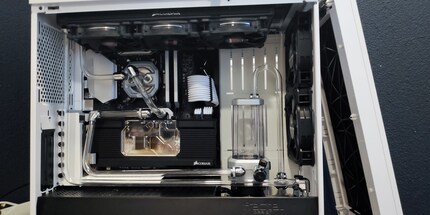
The case still has room for improvement in terms of cable management and water cooling. With two centimetres more in height and width, it would be perfect for building. It is surprising that Fractal has not yet recognised this. This is because most of the Swedes' cases are built on top of each other. It is therefore not specific to the Meshify S2. I already had the same problems with the Define R6. You can also see this review as a representative of the Define S2 and Define R6. Otherwise, there's nothing wrong with the casing. Except perhaps the price: over 140 francs is not exactly cheap. The case is aimed more at people who install components in the medium rather than low price segment.
This was my first case review. I have deliberately refrained from writing anything about the airflow. I would have to systematise the review methodology. For the first review, I therefore focussed on water cooling, build quality and buildability.
Therefore my question to you: Should we review cases more frequently in future and systematise the tests or just one or two cases per year, with a focus on water cooling? Or should we not do any case reviews at all?
digitec case reviews
Should we test more cases in the future?
- Yes, but please systematically66%
- Yes, but please specific tests like for water cooling19%
- No, you have no idea anyway5%
- No, but thank you for your efforts.10%
The competition has ended.
From big data to big brother, Cyborgs to Sci-Fi. All aspects of technology and society fascinate me.


